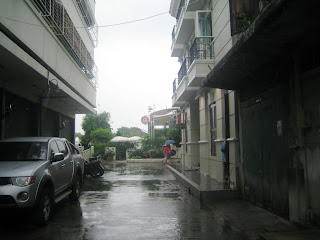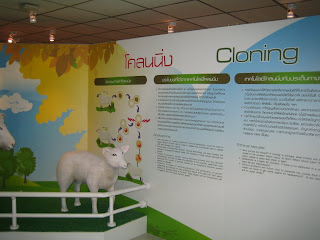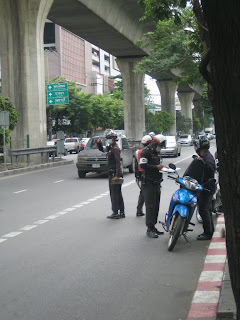 Happy Mother's Day!From left to right: [back row] Risa, Kelly, Janice, Jen; [front row] Pao, his A-ma (grandmother), his A-yi (aunt).
Happy Mother's Day!From left to right: [back row] Risa, Kelly, Janice, Jen; [front row] Pao, his A-ma (grandmother), his A-yi (aunt).This Tuesday was the Queen's birthday, which also made it the day of the year Thailand devotes to celebrating mothers all over the country. Because of the holiday, our classes were canceled for the day, but we still had a full schedule planned with the help of our amazing friend Pao...
 Pao's grandmother's street.
Pao's grandmother's street.As you can see from the photo that tops this post, our first stop of the day involved stopping at Pao's grandmother's house in Chinatown to wish her a very happy mother's day. I had been quite interested to see Chinatown, but hadn't counted on the beautiful displays I saw through the window of Pao's car as we made our way downtown. The main avenue of the city was strung with thousands of tiny twinkling lights, and many storefronts had cleared their windows of merchandise, displaying instead large portraits of the queen and sprays of flowers and fruits. We had a nice time at Pao's A-ma's house, though communication was limited by the fact that she spoke Thai and Cantonese, while our (student) group spoke English, Mandarin, Japanese, and Hebrew (between the four of us). Pao served as translator.
 My wish is finally fulfilled! A pink taxi at last.On left, entering taxi: Janice.
My wish is finally fulfilled! A pink taxi at last.On left, entering taxi: Janice.We visited for a while, then departed for further adventures. Pao parked his car and we hopped into the first of a series of taxis -- finally, a pink one! Because it was the morning of Mother's Day, the street was crowded with flower vendors. These workers wake up hours before sunrise, pick up their flowers, and set up shop on the street stringing them together in garlands for sons and daughters to eventually buy to give to their mothers.
 The flower vendors.
The flower vendors.
Our first stop of the day was
Wat Pho, also known as the temple of the reclining Buddha. This is one of Bangkok's most famous cultural sites, and we were determined not to leave Thailand without having paid a visit.
 Wat Pho.
Wat Pho.
Because of the holiday, the temple was relatively empty, which only added to the sense of serenity and peace of the place. This quiet and sense of space, taken in conjunction with the coolly overcast skies and fastidious cleanliness of the compound, made it one of my favorite temple visits -- one which retained the sense that it was once built (and for many still functions) as a place of worship and contemplation, and not simply as a colorful cultural artifact to be swarmed over by sweaty crowds.
 Topiary at Wat Pho.
Topiary at Wat Pho.
We walked from place to place in the serene grounds, admiring the traditional architecture (note the similarity to buildings at
the Grand Palace). Not only is Wat Pho one of the oldest and largest temples in all of Bangkok, it is also home to one of the country's largest Buddha images: the Reclining Buddha. This Buddha is more than 150 feet long and nearly 50 feet tall, and the temple in which it is housed is not so much a building as a cage for this magnificent sculpture.
 The face of the reclining Buddha.
The face of the reclining Buddha.One of the things I liked best about this enormous Buddha was (oddly enough, considering my usual aversion) his feet. While the Buddha himself is covered in plated gold, his feet are inlaid with mother-of-pearl, depicting 108 scriptural scenes in Chinese and Indian styles.
 The sole of one of Buddha's feet!
The sole of one of Buddha's feet!
Click this to make it bigger and look at these designs --
beautiful illustrations of stories from the Buddhist scriptures. Having walked down one aisle, admiring the length of the Reclining Buddha, you round a corner by his feet and then proceed along his back. At this section of the temple, you can buy a small batch of ceremonial coins, which you drop one by one into little hammered bowls made by the monks with particular resonant qualities. When people drop coins in the pots along this hallway, it echoes softly through the temple and sounds almost like rain.
 Row of hammered pots.
Row of hammered pots.
The other thing for which Wat Pho is famous is as the birthplace of traditional Thai massage. Having paid our respects to the Reclining Buddha, we meandered through the grounds a bit more, winding our way closer and closer to the massage school and service area which still functions out of Wat Pho.
 Some more of the grounds.
Some more of the grounds.One of the neatest things we passed were a series of tiled chedi built to house the ashes of people in the community, whose names were inscribed along its sides. One was decorated with a fresh garland, so large it must have been custom-made that day. This, I imagine, was the way one person who could not spend the day with his or her mother nonetheless found a way of honoring her memory.
 A custom-made Mother's Day garland adorns one of the
A custom-made Mother's Day garland adorns one of the
ceremonial chedi tombs at Wat Pho.Before long, we had arrived at the massage school and were eagerly lined up in a quiet air-conditioned room smelling of eucalyptus and menthol. The massages here were more expensive than the ones on the beach at Koh Samet, but still far cheaper than massages in the US. And the quality of these massages -- wow. I have no words to describe how incredible it was. I felt like I was floating on a cloud for hours afterwards.
 The massage area.
The massage area.Sad as I was when the hour-long massage wound to a close, I was excited about the next stop on our list: lunch. My expectations were more than exceeded, as Pao ordered a delicious spread of dishes, most of which were vegetarian and none of which I would have known to order for myself. Jen, Janice, Risa and I were delighted.
 At our fantastic lunch!From left to right: Jen, Risa, Janice.
At our fantastic lunch!From left to right: Jen, Risa, Janice.The fun wasn't over when lunch ended -- we were off for dessert at a nearby cafe.
 The heavens open!
The heavens open!It's lucky that the cafe was so close, because on our way there, it began to pour! The rain that had been threatening all day came down in sheets as we scurried down the alley to the cafe.
 Police motorcycles.
Police motorcycles.Along the way, we passed some police motorcycles. I paused too suddenly to photograph them, almost creating a collision with Risa, who was running behind me down the street also trying to dodge the rain. I couldn't help it -- I've always got my eye on the cops and nurses of whatever country I'm visiting, because I know they would be topics of interest to my mom and dad (respectively). The combination of police + motorcycles amped the dad interest factor too high
not to stop and click away.
 A tea selection to make my mother proud.
A tea selection to make my mother proud.
At last, we arrived. At the cafe, they had a lovely selection of Twinings teas that would have warmed my mother's heart. I had to take a photo of it for her, but my actual order was something rather different...
 ...tamarind ice cream!
...tamarind ice cream! is a unique fruit, which grows on trees in crunchy brown pods. The pods are allowed to dry, then are cracked open to access the gooey, sour-sweet fruit inside. My ice cream was delicious, and I also sampled some of Jen's passion fruit sorbet and Risa's young coconut ice cream (which had been the other two selections I had most seriously contemplated). The cafe experience itself was lovely -- lace-topped tables in a cute and trendy setting which overlooked the city's main river as the rain sprinkled its surface.
 The mall.
The mall.Eventually, the rain eased up a bit, and we picked our way back between the puddles to the main road, where we caught a taxi to take us to a mall by Pao's home. Janice, Jen, Risa and I had plans -- to get our hair done!
Now, those of you who've followed along since my days in Beijing or Taichung know of the
disastrous hair-related decisions I've made when traveling abroad. I promised my sister before I left for Thailand that I would not succumb to the temptation to cut my hair while I was there, and I'm proud to say that I kept my promise. The stylist kept her scissors and her chemicals far away from my head, but Jen and I did indulge in a shampoo and blow-dry just to keep the other girls company. After that, we had time for a bit more shopping before dinner.
 Group at the restaurant.Left to right: Janice, Me, Risa, Jen, Pao.
Group at the restaurant.Left to right: Janice, Me, Risa, Jen, Pao.Pao took us to a beautiful waterfront restaurant not far from the mall, where we all showed off our freshly-coiffed hair. The coolest thing about the restaurant experience -- aside from the food and drinks themselves, and the beautiful view -- was the Mother's Day ceremony that began about half an hour after our arrival.
 Unflattering shot of me with candle.
Unflattering shot of me with candle.Candles with little paper drip-guards were distributed to every person at the restaurant, and before I was sure what what happening, we were all on our feet with every table raising their voices to sing the
Thai national anthem. None of us except Pao knew the words, so we were content to stand with our candles held high, watching as the tables of mothers and children around us hugged each other and sang.
 Everyone stands to sing the national anthem.
Everyone stands to sing the national anthem.Soon I noticed that we were actually all standing and singing in unison with a scene on the TVs mounted to the ceiling of the restaurant's main pavilion, which meant that pockets of people all of Bangkok -- and perhaps all of Thailand -- were at that very moment also raising candles and their voices to celebrate all the mothers of Thailand, and most especially their Queen. It was a pretty powerful moment.
 The river at night, as seen from our table.
The river at night, as seen from our table.After the ceremony, all we had left to do was order our food -- which was fabulous -- and enjoy the scenery. The lights glimmered on the river as boats cruised by, filled with mothers and children out to celebrate the special day. I ordered a papaya smoothie (which came decorated with a purple orchid blossom), a plate of stir-fried water primrose with chili sauce, and a big plate of rice (which did wonders to blunt the extreme spiciness of the other dish!). A good rule of thumb in Thailand is to order everything with an emphatic "NO SPICY." This doesn't mean that your dish won't be spicy -- it will be -- but you might manage to come out of the experience without having burned your lips and tongue off entirely.
 The official restaurant tuk-tuk.
The official restaurant tuk-tuk.When the meal ended, we reluctantly left the restaurant and were surprised to find the official restaurant tuk-tuk waiting to convey us back to the main road to hail the last of the day's taxis. I must say that while
my tuk-tuk ride in Ayutthaya was nothing less than hair-raising, this one was actually quite pleasant. When I stumbled out of the last one, I vowed never to get back inside another one... which just goes to show that in Thailand (as everywhere else) you should never say never!
 Tuk-tuk ride to the street!Right to left: Pao, Risa.
Tuk-tuk ride to the street!Right to left: Pao, Risa.
Arriving back at campus, I fired off an email to my own mother, to wish her a very happy Thai Mother's Day. It was the perfect ending to a fun-filled day.










































































